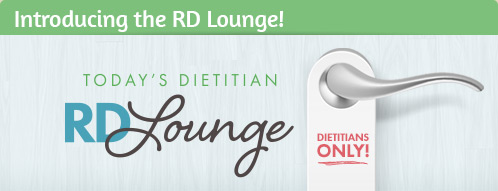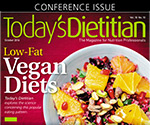 |
 |
Get Cookin’ With Pulses
Ever wonder how to get clients excited about eating more beans, peas, lentils, and other pulses?
In this month’s E-News Exclusive, Today’s Dietitian offers several creative ideas on how to encourage clients to include more pulses in every meal of the day. Pulses have a long history of being a dietary staple in more than 100 countries—dating back thousands of years. They’re chock full of nutrients such as fiber, protein, and potassium and include a variety of phytochemicals.
After reading the article, visit Today’s Dietitian’s website at www.TodaysDietitian.com to read the digital edition of the October issue, which includes articles on low-fat vegan diets, dairy fats, coconut oil, anti-inflammatory foods for osteoarthritis, and our exclusive interview with the winner of the ABC reality TV series My Diet is Better Than Yours Dawn Jackson Blatner, RDN, CSSD.
It was wonderful to see old friends and meet new ones at the Food & Nutrition Conference & Expo™. Please enjoy the E-Newsletter and give us your feedback at TDeditor@gvpub.com, and don’t forget to like us on Facebook and follow us on Twitter.
— Judith Riddle, editor |
 |
 |
 |
Get Powered With Pulses
By Sharon Palmer, RDN
Throughout history, humans relied on pulses—mature, dried seeds from pods, including beans, peas, and lentils—for sustenance. First, our early ancestors gathered these edible seeds in the wild in their hunt for food, and later they began cultivating them during the earliest forms of agriculture. Pulses have been found in caves in Thailand and Egyptian tombs dating back some 11,000 years. In fact, nearly every culture has a pulse in its traditional diet. They’re grown in 173 countries around the world and everywhere in the United States except Alaska. Different regions around the globe have developed unique ways to enjoy pulses—from Mexico’s pinto bean frijoles to French lentil salads to Greece’s herb- and olive oil-infused giant beans.
One of the reasons pulses have become such a backbone of cultural diets is their rich nutrient cache. Many consider pulses to be one of nature’s most perfect foods. One-half cup contains at least 20% DV for fiber, folate, and manganese; at least 10% DV for protein, potassium, iron, magnesium, and copper; and 6% to 8% DV for selenium and zinc; as well as phytochemicals such as alkaloids, flavonoids, saponins, tannins, and phenolic compounds.
Full story » |
 |
 |
More than anyone, your peers understand the joys, rewards, and challenges you face as a dietitian.
With this in mind, Today's Dietitian has created the RD Lounge, a blog written for and by RDs. Our posts are geared specifically to RDs rather than to general consumers, so this blog is unlike any other in dietetics.
Because this lounge is for dietitians only, we’ve built it exclusively as an online sanctuary from all the noise surrounding food and nutrition and as a safe place for RDs to escape and engage with fellow professionals.
Our diverse network of bloggers are all accomplished RDs offering thoughts and philosophies that represent the many different facets of nutrition and dietetics. They’ll also post about real-life experiences, successes, and overcoming challenges. What this impressive group of professionals all have in common is a passion for the profession, an adherence to science, interesting experiences to share, and expertise to impart.
The RD Lounge is now open, and we invite you to read, share, and comment on our posts often by visiting www.RDLounge.com regularly. |
 |
|
|
 |
Impact of Marketing Unhealthful Foods and Beverages on Kids
Research from McMaster University in Hamilton, Ontario, Canada, shows that advertisements for unhealthful foods and beverages high in sugar or salt have an immediate and significant impact on children and lead to harmful diets.
The study, published in the scientific journal Obesity Reviews, examined 29 trials assessing the effects of unhealthful food and beverage marketing and analyzing caloric intake and dietary preference among more than 6,000 children. Researchers found that the marketing increased dietary intake and influenced dietary preference in children during or shortly after exposure to advertisements.
Behnam Sadeghirad, PharmD, lead author of the study, says that these findings demonstrate the influence that these advertisements, a growing epidemic, have on children’s food choices.
Read more » |
 |
 |
Gastric Bypass May Bring
Infant Nutrition Deficits
Infants born to women who’ve had a Roux-en-Y gastric bypass are more likely to be small for their gestational age and have nutrition deficiencies at birth, according to WebMD.
Poor Exercise Habits May Follow Teens
Into Adulthood
Most American teenagers don't get enough exercise, and they often stick with their sedentary ways as they enter adulthood, according to Fox News. |
 |
 |
In the November Issue
Diabetes Bootcamp
Meat Snack Fervor
Frozen Food Innovations
Mindful and Intuitive Eating During the Holidays
Combating Cancer Malnutrition |
 |
|
